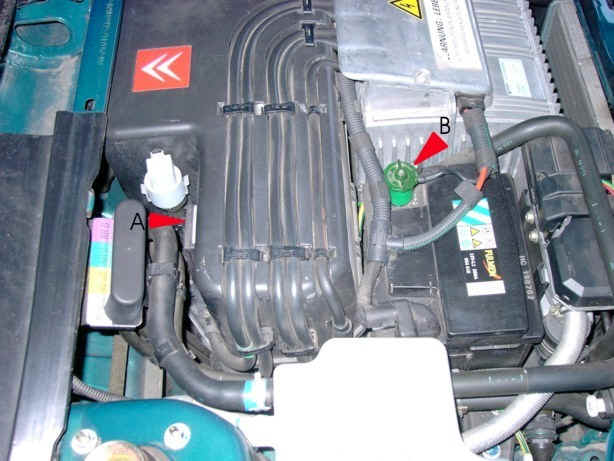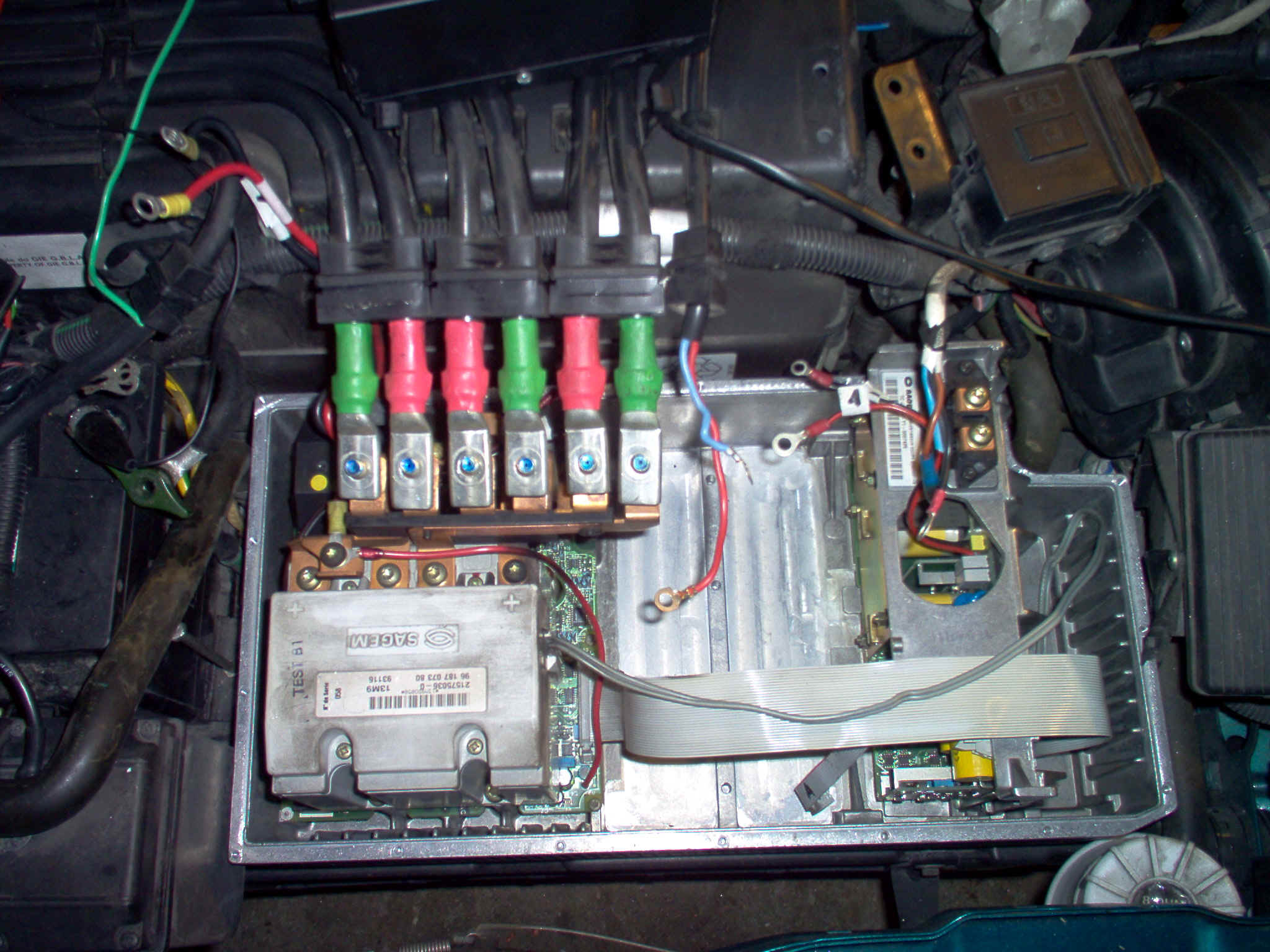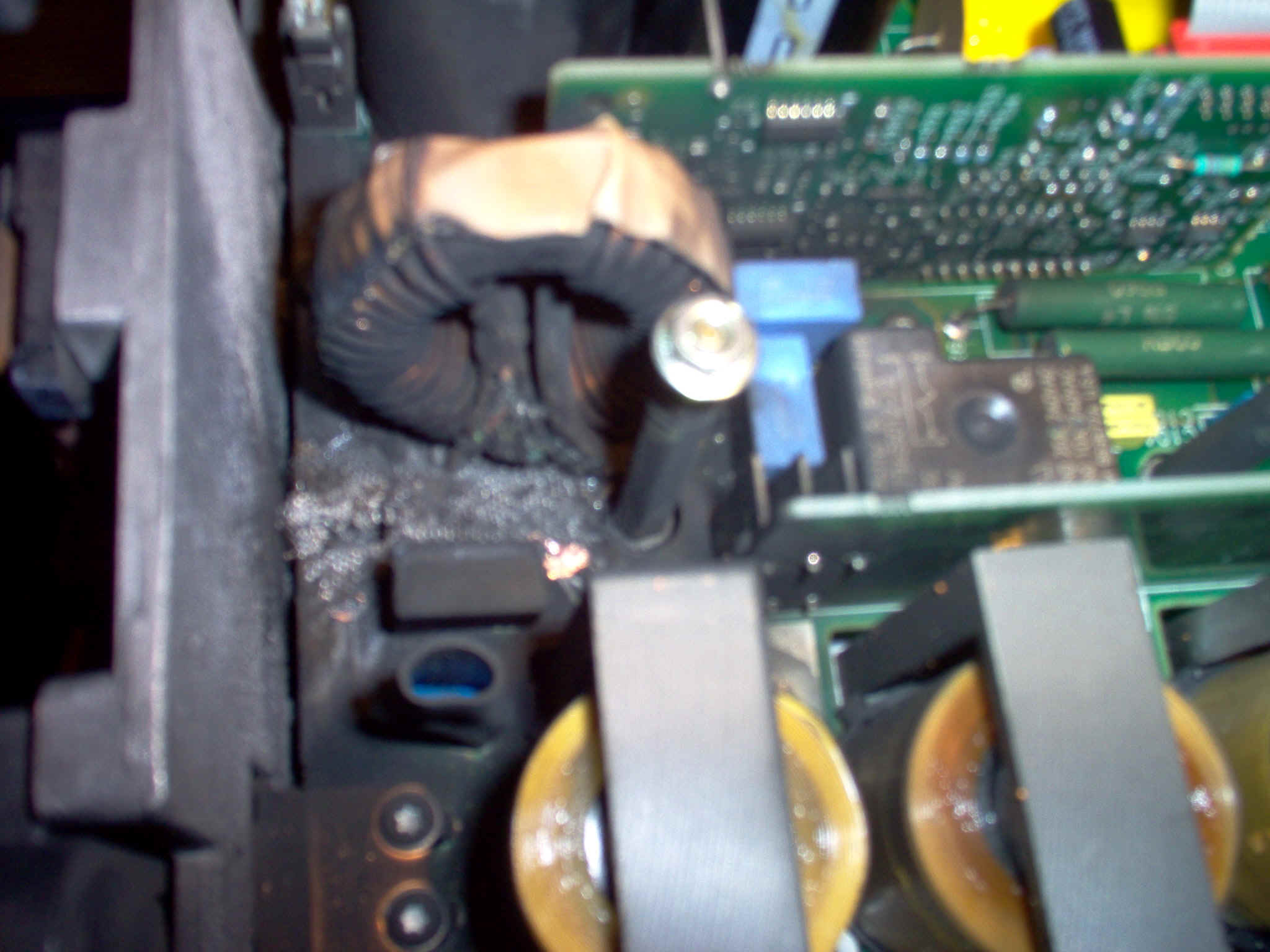|
Guide to the problems with
Peugeot 106E and Citrōen Saxo electrical worker1)
of Giovanni Tinetti and Maurizio Fabbro
1) Famous: the brought back suggestions can be apply to
you also to: - Citroźn AX electrique
- Renault Clio Electrique
- Citoźn Berlingo Electrique
- Renault Electrique Partner
Summary:
- Introduction
- Disclaimer
- technical
Advisor, our mechanic of
confidence, Sig. Angel Brambilla di Camorino
- Case
a) charges to 50%, lights the
Electrical Fault lamp and the car cannot be charged any more.
- Case
b) the cooling pump impeller
is stuck.
- Case
c) the charger short
circuits and becomes unusable. For the rest the car works perfectly.
- case
d) the motor goes in jerks or
it does not recharge in overrun
- case
e) substitution of the brushes - case
f) dress in top to one goes
them of the sopraceneri; I must by force come down until Mendrisio in
order making the service of the batteries my Peugeot? (Sorry,
I can't make head or tail of this one!)
- case
g) resolving the problem
of the reduced range (caused by cold batteries) in winter
- to
avoid problems of damage to the batteries
Documents enclose to you:
- Directives
of Leroy-Somer maintenance for the motors to continuum flow (pdf)
- Bulletin
of delivery brushes Casram (pdf)
- official
Sheet given Batteries SAFT STM5-100, officially in equipment to the
vehicles Peugeot and Citroen
- Prescription
of emergency batteries SAFT STM
- Manual
of the use of batteries SAFT STM (modality of loads and maintenance)
- Relationship
on the usury of batteries SAFT STM written up from the Danish Committee
Vehicles Electrical workers
Introduction
Our club is formed mainly from possessory of vehicles electrical
workers, of which one group of forty of persons posseggono the models
electrical workers of the two famous French houses. Unfortunately the
two companies, and in particular Peugeot, have lost every interest in
this branch of activity (the subsidies are ended), and would prefer to
see to disappear these scomodi (for they) models.
In truth it is Peugeot 106E that Citroźn Saxo is two optimal vehicles
in their kind, solos that, like whichever electromechanical product,
need of some ordinary maintenances, that they have been to our way to
see intentionally hidden in order not to discourage the possible buyers.
It is obvious that to the day today nearly all the vehicles in
circulation would need some maintenances. For reasons of image and
marketing, the parent companies cannot reveal the information omitted in
phase of information to the customers, and therefore not repairable
total hides behind improponibili diagnoses of breach or however of
varied members, with costs of substitution forbidden to you.
In these years we are resolutions to isolate the main found problems on
this type of vehicles, and of continuation we propose you some simple
solutions to recurrent events:
Disclaimer:
The information brought back in this
page are all riconducibili to our personal experiences, and the
technical solutions have been all effectively experimented on our
vehicles. In good part draft however of manual operations to carry out
itself on the vehicle that they demand determined acquaintances. For
eventual damages we cannot assume responsibility. For ulterior
information or in order to communicate the your experiences to us, you
can contact us to the address comitato@ecovelclub.ch
Technical
advisor, our mechanic of confidence, Sig. Angel Brambilla di
Camorino
From the beginning of 2004, it stews of the treatment received in
particular from Peugeot, we have tried a mechanic that it worked just in
(therefore not legacy to representation duties), and that had still that
passion necessary in order to operate on vehicles outside of the
ordinary. We have found the solution to our problems in the person of
Mr. Angelo Brambilla di Camorino, than in more occasions happening has
worked on our vehicles (executing all the operations described later on)
with optimal and truly modici prices.
In these years, recovering vehicles out of service, with Mr. Brambilla
we have been able to collect all pieces series of a second hand,
specific reciprocation of these vehicles electrical workers, than hour
we can put to disposition of the associates in difficulty.
In particular we have hour to disposition:
- two motors of reciprocation
- one complete control panel electronic, with charger
- the Webasto heating
- several control panels and small pieces
These pieces are to disposition of "the needy" associates.
Mr. Brambilla is raggiungibile to number 0918578674. Its workshop finds
beside the restaurant "the Bubble" of Camorino.
Case a) charges to 50%, lights the
Electrical Fault lamp and the car cannot be charged any more.
Cause: the pump of the cooling system is the most used part more than all
the vehicle. In fact it works is during loads that during the movements.
This pump is set in action from a small engine electrical worker to
brushes. The usury of the brushes ago that after ca. 20' 000 Km of firm
distance this small engine. The temperature in the load-batteries and
the batteries increases beyond the concurred limit and the control panel
electronic blocks the process.
Official solution: left the machine dov' is and calls the ACS in order
makes you to carry the car in practical garage........in remains on
foot.
Proposed solution: Inserted the contact and you open the cowling. The
pump is found on the skillful side of the radiator. When it is in
function the pump emits the classic buzz that characterizes these
vehicles. If not felt it, tried to leggermente picchiettare the small
engine of the pump with an English key, and this recommences to turn.
The spy however remains ignited, and you cannot recharge. Your garagista
one will say to you that it must execute a reset of the control panel electronic, and that therefore you must portargli the vehicle
absolutely. In truth in order to execute a reset of the control panel it can be proceeded in the following way:
1. To reset the car
2, Remove the main fuse of the block of batteries of traction (situated
behind the block of the electronics, cfr. photo 1 - To)
3. To unscrew the pole negative of the service battery 12V (the screw in
green plastic, cfr. photo 1 - B)
4. you attend 5 minuteren.
5, Riavvitate the pole negative of the service battery 12V (photo 1 - B)
6. Photos 1 reinserite the main fuse of the block traction batteries (-
To).
IMPORTANT!! NOT TO INVERT the POINTS 2-3 And 6-7!!

photo 1) under the cowling of one Citroźn Saxo electrical worker
To this point the spy will be passing, and the car will work perfectly.
Therefore you will have still at least two or three weeks of time in
order to replace with calm, and without scomodare ACS, the water pump.
Conclusion: every ca. 20' 000 Km has one spold of ca. 250.-CHF in order
to entire replace the pump (more hours than job, material small, etc).
All only why the brushes in the small engine of the pump cannot be
replaced!!!! (whichever small engine of the sort previews the lodging
for the brushes with substitution...). Could not be equipped to the car
of one pump with motor to induction, even with cost double of the
pompetta, but then effectively without maintenance for all the duration
of life of the car?
Case b) the firm impeller of cooling not
more.
This disadvantage can make to think to an breakdown of the sensor of the
temperature of the water (happens also in the conventional vehicles...).
Official solution: If capacities the car in garage, you sostituiranno
scatoletta containing the electronics of management of the impeller (scatoletta
in embedded black plastic through a support on the right of the block in
aluminium). I do not know how much exactly costs the substitution, but it
is sure not R-a.buon.mercato.
Proposed solution: executed "reset" of the control panel electronic with the system introduced in the case to) (points from 1 to
6). Like of spell, and without to spend cent, the impeller will
recommence to work normally. In fact in the greater part of the cases
draft of an error not specified of the software of management of the
cooling.
Conclusion: in a generalized manner, if it succeeds a disadvantage that
you think to you has an origin electronic, you try to resolve it with
the system of the reset (you see points from 1 to 6 in the case To). A
lot probably, if capacities the car in garage, will connect the control panel
to the apparatus of diagnostic, and, also in an other
way, they will make the same thing exactly.
Case c) the charger enters in short circuit
and becomes unusable. For the rest the car works perfectly.
When connected the car to the taken one of loads, the valve jumps.
Official solution: They will say that it must completely replace the
block of the electronics, why draft to you of an only difficultly
repairable unit. Cost of the operation: 9000 CHF for the block of
electronics + job etc.!!!!
Proposed solution:
1) Remove, extracting it completely and depositing it in a sure place,
the main fuse of the block traction batteries (cfr photo over, fuse To).
This operation is most important in order to avoid a electrocution
danger!!
2) To make sure itself that the cable of recharges it is scollegato from
the vehicle.
3) Remove the cover of the electronic block, simply unscrewing the lives
placed along the edge (is not necessary to remove the cooling water, in
how much is not entered in contact with the circuit of same cooling).
4) To this point the situation like from photo 2 appears you:

photo 2) the block of the open electronics
5) On the circuit of entrance 220 V, before arriving to the charger true
and just a filter is installed. In our case the filter has gone in short
circuit and is burnt. It has been enough to remove the filter and to
connect the charger directly, and all it is begun to rifunzionare in the
best one of the ways. And this in two hours of job and without pieces of
reciprocation.

photo 3) the filter damaged and in short circuit
Conclusions:
1) we do not think that all the breakdowns to the caricabatteria are
riconducibili to the short circuit of the filter, however also in this
case the "pronosticata cure" in garage was the complete
substitution of the electronic block, for the modica sum of 9000 CHF......
2) Like very visible from the photos, the electronics are not structured
in an only block, but it is distinguished in several cards very
separated (charger, electronic of power, inverter, card of
regulation.....) sostituibili or, sure singularly still better
repairable......
case d) the motor goes in jerks or it does
not recharge in reduction
Official solution: complete substitution of motor block (3000 CHF + job
etc....)
Proposed solution: This behavior can have external causes also to the
same motor, between which the also oxidation of the potenziometro of
regulation connected mechanically to the accelerator. In the greater
part of the cases the problem derives but from the usury of the
carboncini of the traction motor, and, unfortunately in some cases, also
from the usury of the collector.
The motor mounted on the models Peugeot and Citroźn is a Leroy-Somer,
and even if draft of a special product constructed for these two
companies, it sottostą to the
directives only generates them
of maintenance rilasciate from L-S for all its motors DC, (not tried
to contact Leroy-Somer of this product on purpose, they will say that
draft to you of an exclusive feature PSA, and that therefore they are
held not to rilascire some data or information...). As explained in the
directives cited, to second of I use, the collector of the motor must
more or less frequently be rectified, in order to assure a good
operation. In term of costs this is only translate in hours of job, in
how much no piece must be replaced. In order to allow the turning of the
collector, it must but extract the rotor from the motor, and therefore
complete taking apart must be proceeded to one.
This job has been executed on a motor with ca. 60' 000Km of distance,
and has given optimal turns out to you. After a year the machine works
better than from new.....
Like containing the costs: it considers the costs you elevates you of
this job and the relatively long times of execution, we have prepared an
offer of favor for the EcoVelClub associates: Currently we have unmotore
of supply, deposited near the Garage Brambilla di Camorino, our mechanic
of confidence. Associates EVC who will have problems to the collector
will be able to o from our mechanic of confidence (the same one that has
already executed the job a year makes), that it will take apart their
motor and rimonterą the motor rectified for a figure of ca. 350 CHF.
The EVC later on will make to rectify the taken apart motor, putting it
of new to disposition of the associates. For greater information you can
contact us to the email comitato@ecovelclub.ch.
Conclusions: Brazen and scriteriata politics of Peugeot R-with regard to
this problem do not have need of ulterior comments. Also the press has
already had way to take care itself some. The answers had from Peugeot
always have been superficial, or quite lived in air! The better thing is
to try one solution alternative that scavalchi the same producer,
without falling in pathetic exchanges of accusations and refutation. The
attitude of Peugeot is leggibile clearly in the fact that the company
has decided to completely withdraw and to destroy a replaced defective
motor in guarantee, rather than to yield it to us (we were disposed to
pay it, oltretutto....)
case e) substitution of the carboncini, you
knew it?
Who of you has been informed, since the beginning, of the necessity to
replace the carboncini of the motor of every traction ca. 25' 000 Km, is
prayed to leave a message in the forum..... Frankly, anch' I when I have
acquired my car electrical worker, they are left me to spool then from
the publicity used from Peugeot: - "a electric motor who ago a
million kilometers without need of services!!" - A slogan that
could serve to paliare the fact of having to pay 220 CHF month for the
batteries, but that sure it came to fall, when, with the invoice of the
water pump (you see case To)) and of the maintenance of the batteries,
law in the invoice pure "substitution carboncini 250 CHF +
job!!!!). Hour we become account of the fact who the carboncini are
constructed with the maximum precision in order to allow the better
operation of the motor, but 250CHF for four pezzetti of coal....
Proposed solution: The Casram, ticinese company oltretutto, are an
optimal carbon manufacturer for electric motors. If you want to
purposely replace carboncini (4 pieces) with the produced equivalent
Casram (devised for we), you can order the article not. 05.103226, at
the price of CHF 81,55 (Vat and enclosed expenses), that is to ca. 1/4
of the price proposed from Peugeot. For
sincerarvi you can here see the invoice rilasciata from Casram with all
the necessary data for commands it.
Conclusions:
If you want to avoid problems to the collector (case c)), more often
replaced the carboncini, and not waited for that ve they replace them of
soppiatto during a regular service. Replacing the carboncini every ca.
15000 Km avoided many troubles to the collector. Moreover, commanding
the Casram products, it will cost to you less however than to replace
them with the product Km originates them every 25000.
case f) dress in top to one goes them of
the sopraceneri; I must by force come down until Mendrisio in order
making the service of the batteries my Peugeot?
Not, you can make the service to the batteries near whichever
concessionato retailer for the vehicles PSA electrical workers.
Therefore you can go calmly also from a Citroźn concessionaire (and
viceversa).
case g) Like
resolving the problem of the autonomy lessening (cause cold batteries)
in winter
Sure there are shrewed that in winter the batteries succeed to
distribute little energy, for which in particularly cold days, even
found to travel to 15 Km/h when the pointer of the state of loads
indicates still 35%. The reason is that the cold inhibits the reaction
to the inside of the batteries, and they succeed to distribute little to
ampčre that in summer.
Simple one exists a method much in order to obviate to this
disadvantage: The system of cooling to water is an important element in
this type of vehicles; it avoids the overheating of the electronics of
power, the charger and the same batteries. Of norm the NiCd elements, in
order not to lose strength itself, do not have to be capacities to
advanced temperatures to the 45-50 °C.
In winter but, the cooling system decidedly turns out overdimensioned,
and contributes to cool the batteries too much. To this point enough to
take part as it was made once on the old vehicles, covering with one
template the radiator. Since the radiator never does not exceed
temperatures of 40 °C, you can wrap it with a simple plastic bag,
scollegando preventively the cooling impeller. With this sagacity
diminished of fact the system effectiveness of cooling, and the heat
dissipated from the electronics comes used in order to heat leggermente
the batteries, being allowed you to have a perfectly comparabile
autonomy with that summery one. The operation is not critical, in how
much is the electronics that the batteries ulteriorly are protect from
temperature sensors that they block the vehicle in overheating case. You
must only make attention to two particular:
- not left to support the plastic bag on the Webasto, to the left of the
radiator. In fact, if used the heating, the webasto rather catches up
elevated temperatures.
- not scollegate the pump of circulation of the water. In this case you
would risk to damage the electronics.
This winter sagacity has allowed me to cover the Claro-Airolo distance
with the same consumption of energy, is in summer (+24 °C) that in
winter (-3°C).
to
avoid problems of usury to the batteries
All that that happens to the batteries has not had to the effect
memory.....
The true effect memory, that is a slow lessening of the ability to the
batteries, is effectively contrastable executing a complete series of
charges and scariche, and it is not an irreversible effect.
In the relationship written up
from the Danish committee for the vehicles electrical workers,
clearly it is documented like the series of batteries STM5-100 produced
from the SAFT between 1984 and the 2000 introduced of the serious
problems of quality of the separator used to the inside of the cells.
This phenomenon door often and gladly to the putting in short circuit of
the element, with remarkable loss of power in little weeks. The details
of the investigation are leggibili in the
attached relationship, unfortunately at the single moment in
English. From the tenor of the conclusions it is understood but as
Peugeot and Citroen have adopted also in the Scandinavian countries the
same politics of "scaricabarile"!!
The described phenomenon comes emphasized in the case of uses of the
batteries with an insufficient level of electrolyte. To this purpose
recording is necessary on the modality of appraisal of the level of
water in the batteries: All the customers of Peugeot and Citroen
electrical workers know that, to relatively regular periods, the spy of
the liquid level in the batteries ignites itself, and the machine must
be capacity to the service batteries. All but do not know that the
ignition of the spy does not depend directly on the level of present
liquid in the batteries, but from the number of cycles of it only
recharges complete you execute yourself from the charger. In practical
the factory it has estimated the hypothetical electrolyte evaporation
from the batteries during a cycle of recharges, succeeding therefore to
establish to great lines the lowering of level for every recharges. This
is a practical system if the technical complication of the measure of
the level in 20 batteries is considered, but does not keep in mind a
factor that can be a lot important; the partial charges. In fact, if you
load the car to es. until 95% and then the detached ones, the contatore
memorizzerą loads completes.
Imagined to execute 50 consecutive ricariche to 95%: for the control
level the batteries are still full of liquid..... but you in truth
travelled to dry! (with the possibility that the problem described
previously is taken place....).
In order to contrast this problematic one, you can use the following
sagacities:
- tried, in the limit of the possible one, to unload and to recharge
completely the batteries (improves also the rendering)
- avoided of the long periods of inactivity of the vehicle. It is
demonstrated that the vehicles the electrolyte uses you regularly has
little problems than battery (evaporates even if the vehicle is
firm)
- 4 months executed a control of the level of electrolyte at least once
every, even if the spy still has not ignited itself
- Verified that the production of your batteries has happened after
2000, year in which SAFT finally it has been decided to correct the
constructive defect of the batteries. Eventually you can try to turn you
to the official importer of batteries SAFT for
the Swiss
|

